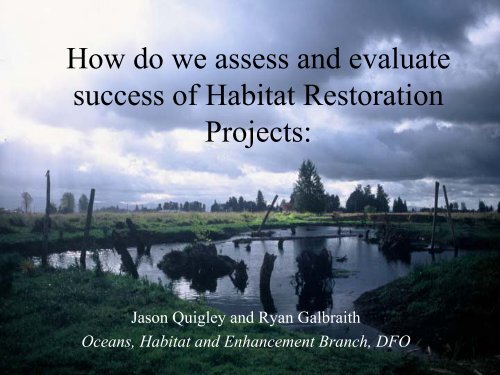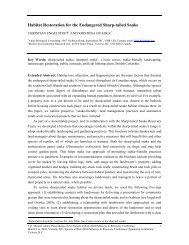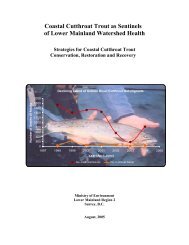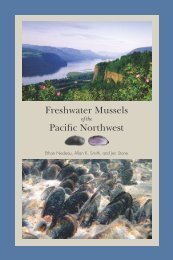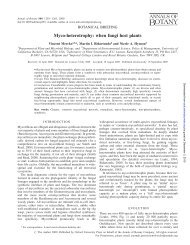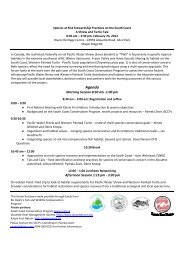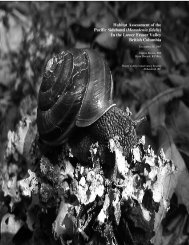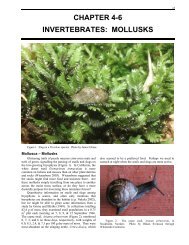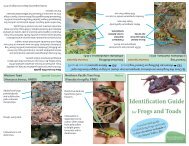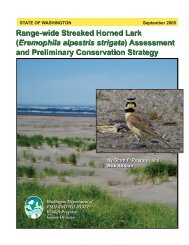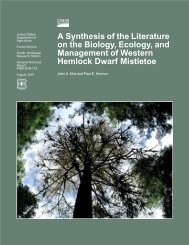How do we assess and evaluate success of Habitat Restoration ...
How do we assess and evaluate success of Habitat Restoration ...
How do we assess and evaluate success of Habitat Restoration ...
- No tags were found...
Create successful ePaper yourself
Turn your PDF publications into a flip-book with our unique Google optimized e-Paper software.
<strong>How</strong> <strong>do</strong> <strong>we</strong> <strong>assess</strong> <strong>and</strong> <strong>evaluate</strong><strong>success</strong> <strong>of</strong> <strong>Habitat</strong> <strong>Restoration</strong>Projects:Jason Quigley <strong>and</strong> Ryan GalbraithOceans, <strong>Habitat</strong> <strong>and</strong> Enhancement Branch, DFO
<strong>How</strong> <strong>do</strong> <strong>we</strong> define <strong>success</strong>?1. Increase habitat productive capacity2. Change social values – awareness <strong>of</strong><strong>and</strong> support for habitat conservation <strong>and</strong>restoration3. Adjust future restoration efforts bybuilding on our <strong>success</strong>es <strong>and</strong> learningfrom our mistakes
What are the benefits <strong>of</strong> evaluating<strong>success</strong> <strong>of</strong> restoration projects?• Improved public support <strong>and</strong> awareness <strong>of</strong> thevalue <strong>of</strong> habitat restoration• Enhanced cost effectiveness• Ability for shared learning <strong>of</strong> what is working <strong>and</strong>what is not.
What are the challenges to evaluating<strong>success</strong> <strong>of</strong> restoration projects?• The social value <strong>of</strong> restoration projects is <strong>of</strong>tenintangible• Biological systems are dynamic• Diverse groups conducting <strong>and</strong> monitoringrestoration projects• These make st<strong>and</strong>ardisation, measurement <strong>and</strong>quantification difficult
<strong>How</strong> <strong>do</strong> <strong>we</strong> overcome these challenges toevaluating <strong>success</strong> <strong>of</strong> restoration projects?• Development <strong>of</strong> a framework for evaluation <strong>of</strong>restoration projects in a consistent <strong>and</strong>st<strong>and</strong>ardised manner – Guidebook.• Purpose: Guidance to <strong>evaluate</strong> changed socialvalues, to address biological variability <strong>and</strong> toprovide st<strong>and</strong>ardised approaches for the diversity<strong>of</strong> groups <strong>assess</strong>ing restoration projects.• Intended audience: DFO, Industry, communitygroups, consultants
Monitoring <strong>and</strong> Assessment Guidebook - Outline1. Three level framework:• Qualitative monitoring• Project effectiveness monitoring• Program effectiveness evaluation2. Hypothetical case studies3. What to measure? <strong>How</strong> to measure it? Checklists. Data forms. Experimental designs.Data analyses. Reporting formats.
Monitoring <strong>and</strong> Assessment GuidebookThe social component <strong>of</strong> project effectivenessmonitoring.<strong>How</strong> did the project affect social values in the community?• awareness <strong>of</strong> fish <strong>and</strong> fish habitat?• attitudes towards habitat preservation with respect to l<strong>and</strong><strong>and</strong> water use practices?• support for fish habitat restoration?Approaches:• <strong>How</strong> to <strong>do</strong>: opinion surveys, questionnaires, before <strong>and</strong>after, question samples <strong>and</strong> analytical approaches
Monitoring <strong>and</strong> Assessment GuidebookThe biological component <strong>of</strong> project effectivenessmonitoring<strong>How</strong> to overcome the dynamic nature <strong>of</strong> biological systems?Experimental designs are used to establish that anobserved change is due to a project’s impact rather than tomere chance or some other unknown effect.Outlines:Baseline data – what to measure <strong>and</strong> howControl sites – how to selectReplication – how many are necessary, frequency <strong>and</strong> duration<strong>of</strong> monitoring
Conceptual experimental design resultsProjectSiteBiomassControlSiteDifferenceBeforeProjectImplementationAfter
Monitoring <strong>and</strong> Assessment GuidebookExampleFor example, to <strong>evaluate</strong> <strong>success</strong> <strong>of</strong> a restorationproject an experimental design will allow us toans<strong>we</strong>r the following questions:• Has juvenile density <strong>of</strong> a particular speciesincreased at the site?• If it has, is the increase due to recruitment withinthe site, or did the fish simply move in fromadjacent habitats?• If recruitment has increased, is it due to therestoration or is this just a particularly good yearfor fish?
Monitoring <strong>and</strong> Assessment GuidebookThe biological component <strong>of</strong> project effectivenessmonitoring<strong>How</strong> to overcome the dynamic nature <strong>of</strong> biological systems?Multiple indicators – an array <strong>of</strong> ecological indicators atseveral trophic levels will represent the capacity <strong>of</strong> a habitat tosupport fish more accurately than current fish densities, whichare influenced by other factors (e.g. fishing pressure, oceanconditions, production bottlenecks).
Monitoring <strong>and</strong> Assessment GuidebookProgram Effectiveness EvaluationIn addition to determining <strong>success</strong> <strong>of</strong> individualrestoration projects, the guidebook promotesconsistent metho<strong>do</strong>logies <strong>and</strong> experimentaldesigns so that program effectiveness evaluation<strong>and</strong> large-scale adaptive management can occur.
Program Effectiveness EvaluationObjectives• To <strong>assess</strong> <strong>success</strong> <strong>of</strong> management actions (e.g. restorationprojects) at a watershed <strong>and</strong>/or program level.• To <strong>assess</strong> relative effectiveness <strong>of</strong> different restorationmethods.• Depends upon collection <strong>of</strong> comparable data across largenumber <strong>of</strong> projects conducting habitat restoration.
Program Effectiveness Evaluation• The pooling <strong>of</strong> this data, analysis <strong>and</strong> reporting enables us tobuild on our <strong>success</strong>es <strong>and</strong> learn from our mistakes (i.e.feedback loop).• As an outcome, management approaches (restorationstrategies) can be adjusted to be more <strong>success</strong>ful.Benefits include:• Improved cost-effectiveness <strong>of</strong> restoration strategies.• Improves public support <strong>of</strong> restoration activities.• Enhanced shared learning on what is working <strong>we</strong>ll.
Design AProject 1Project 1ImplementationProject 1EffectivenessMonitoringAdjustManagementDecisionsDesign AProject 2Project 2ImplementationProject 2EffectivenessMonitoringDesign BProject 1Project 1ImplementationProject 1EffectivenessMonitoringDesign BProject 2Project 2ImplementationProject 2EffectivenessMonitoringProgram Effectiveness Evaluation(compares design A to design B)
<strong>How</strong> to <strong>assess</strong> <strong>and</strong> <strong>evaluate</strong> <strong>success</strong> <strong>of</strong>restoration projects?In summary, the benefits <strong>of</strong> <strong>assess</strong>ing restorationprojects include the ability to….• Demonstrate that capacity was built within thecommunity• Demonstrate habitat restoration objectives met• Improve public support <strong>and</strong> awareness <strong>of</strong> the value<strong>of</strong> restoration• Enhance cost-effectiveness• Opportunity for shared learning – what is working<strong>and</strong> what is not
<strong>How</strong> to <strong>assess</strong> <strong>and</strong> <strong>evaluate</strong> <strong>success</strong> <strong>of</strong>Summary:restoration projects?• Assessment plan should be developed at the project designstage• Success <strong>of</strong> restoration projects should include an evaluation<strong>of</strong> changed social values.• A multi-metric approach <strong>and</strong> quantitative experimentaldesign will assist project level evaluations.• Consistent <strong>and</strong> st<strong>and</strong>ardised methods across many projectswill enable large-scale adaptive management.
<strong>How</strong> to <strong>assess</strong> <strong>and</strong> <strong>evaluate</strong> <strong>success</strong> <strong>of</strong>restoration projects?Possible next steps:• Guidebook is in final draft stage – publication spring 2005• Initiate the framework internally for restoration activities(opportunity for partnership with PSF on select watersheds)• Opportunities for external training <strong>and</strong> outreach workshops• Coordination role (methods, data collation – centralrepository, analyses) with internal DFO projects (includingthose with our partners)
Thank-You


